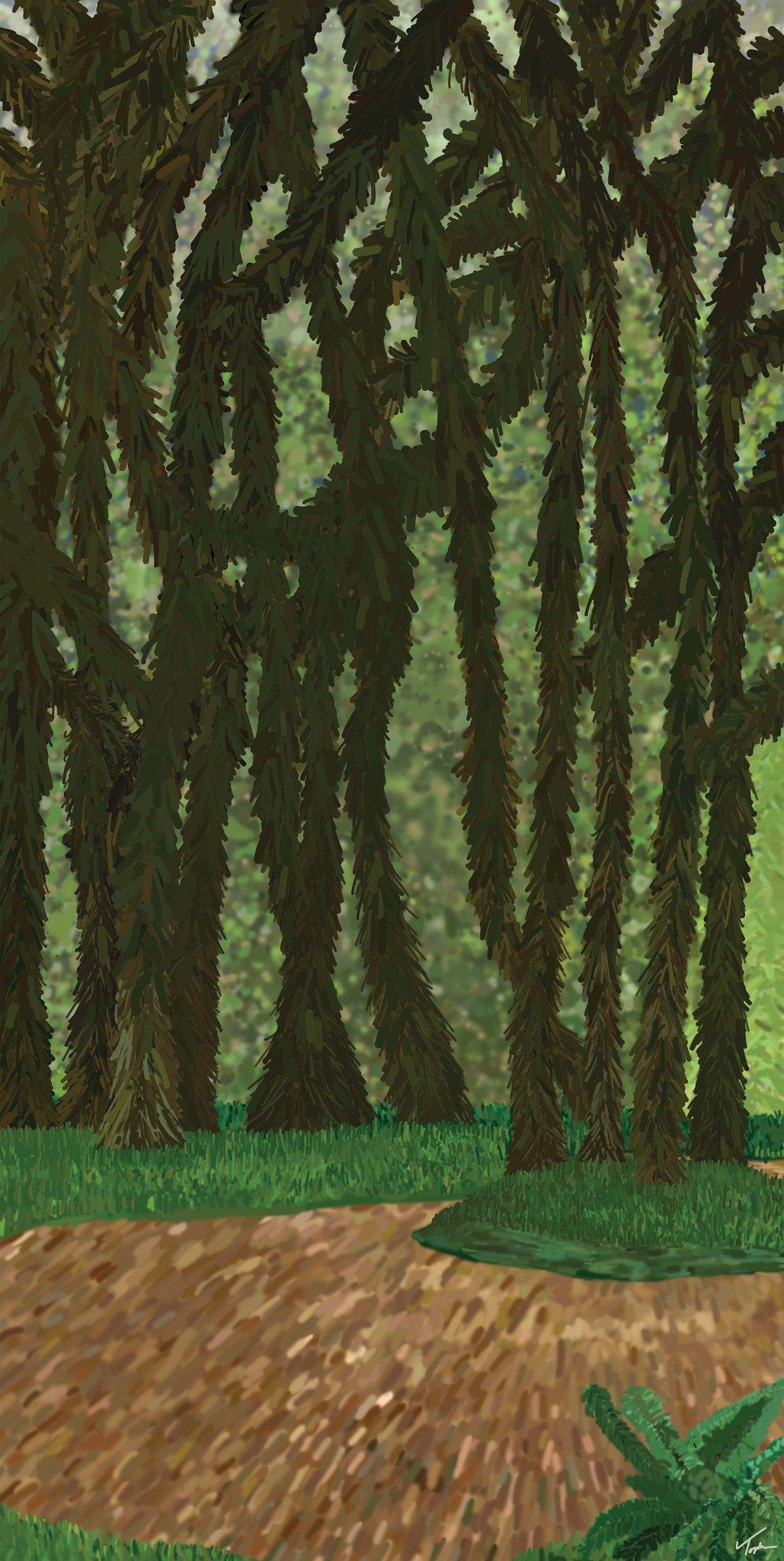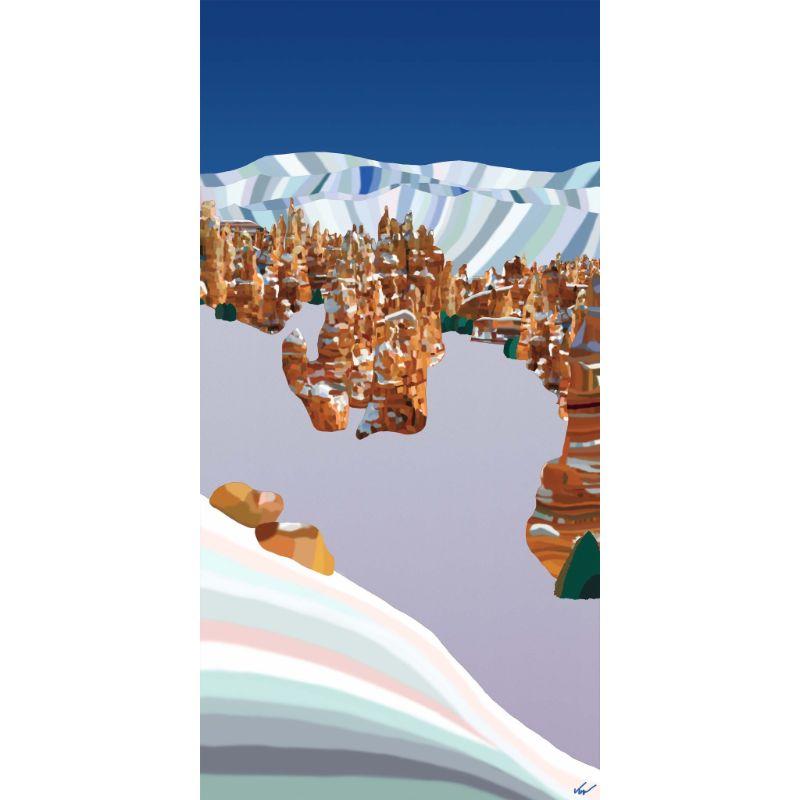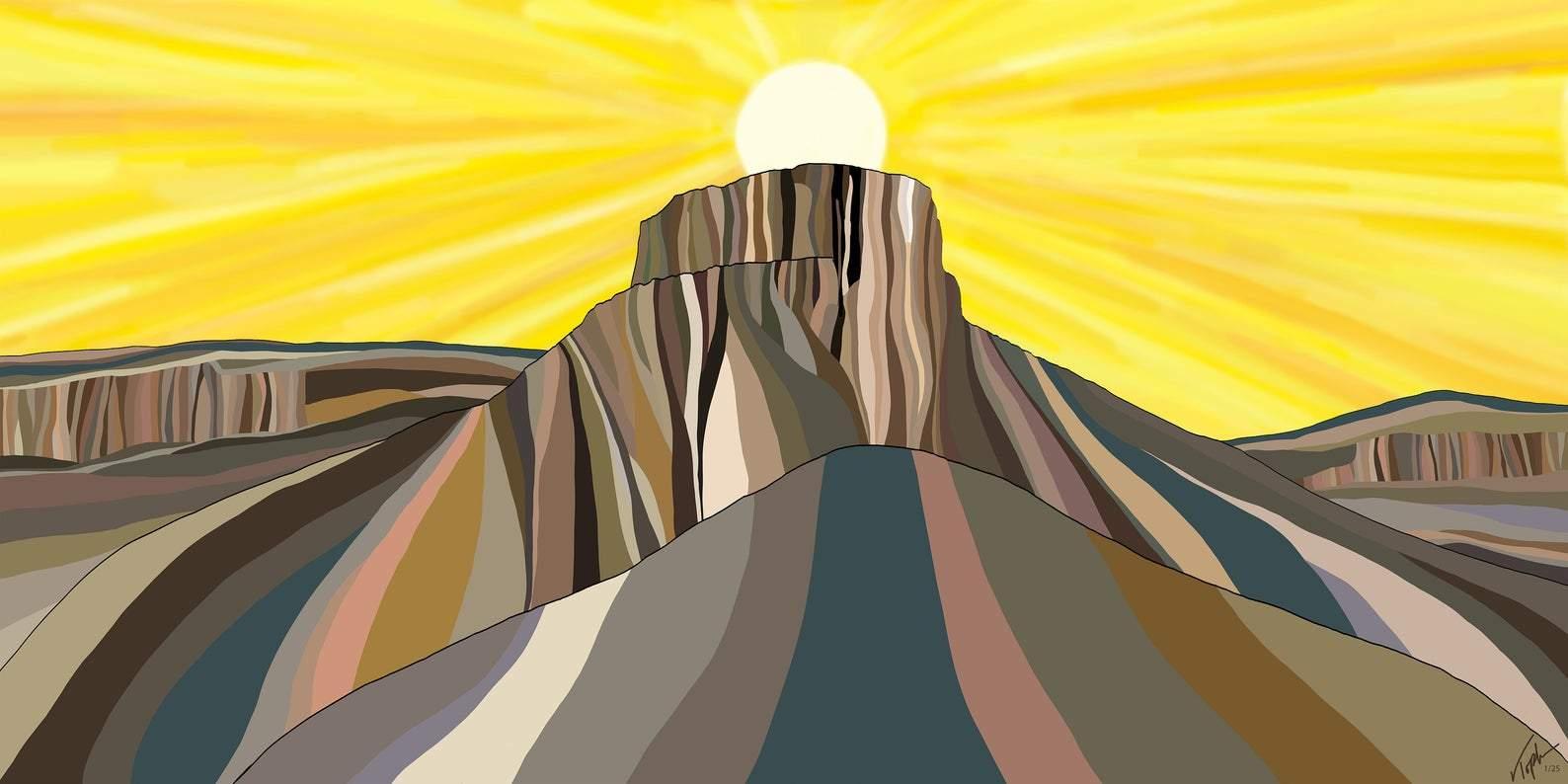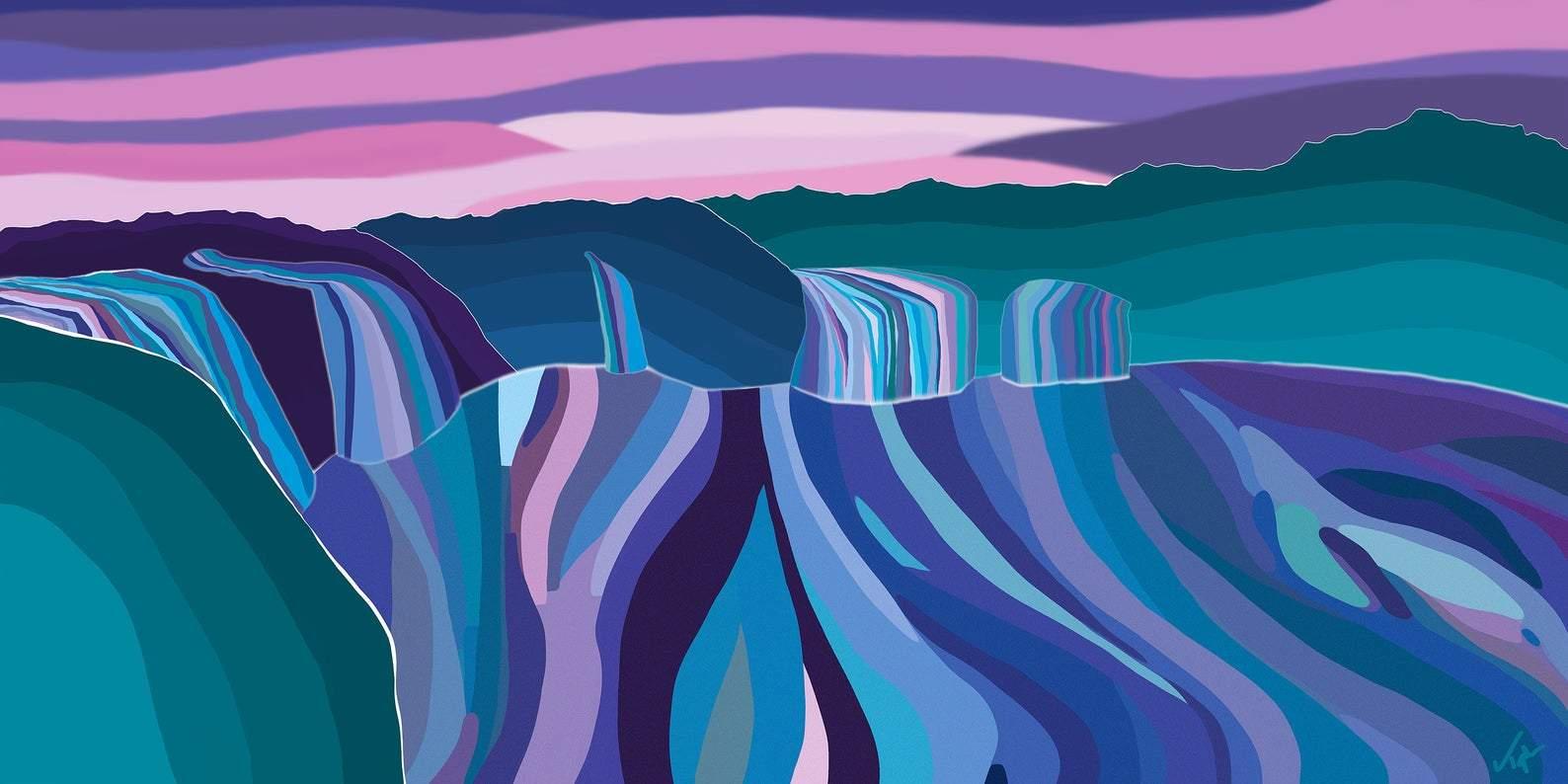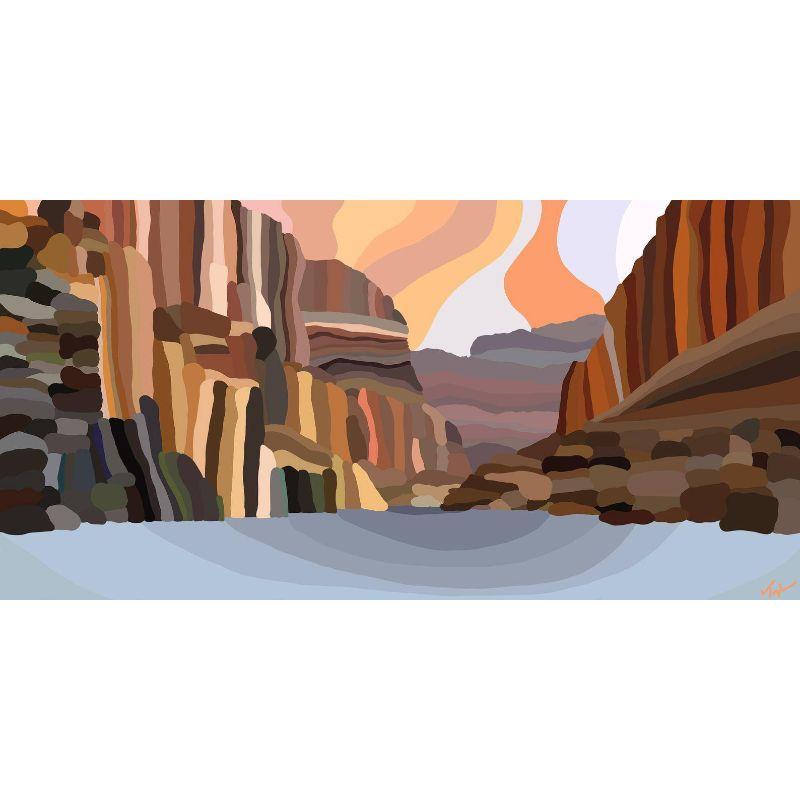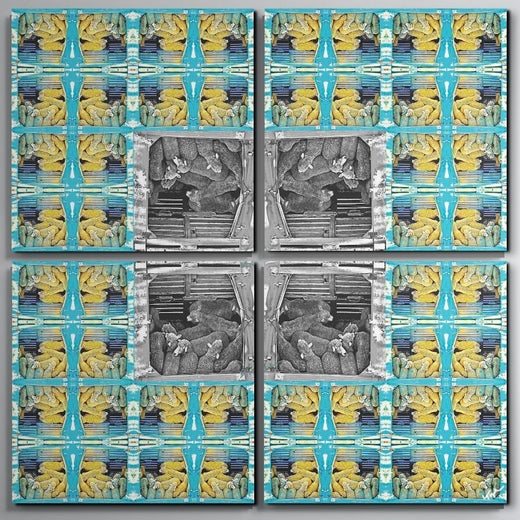Items Similar to Congaree National Park, Modern Impressionism Landscape Painting, Forest, Ltd Ed
Want more images or videos?
Request additional images or videos from the seller
1 of 9
Topher Straus Congaree National Park, Modern Impressionism Landscape Painting, Forest, Ltd Ed2021
2021
About the Item
This large limited edition modern landscape painting of Congaree National Park, in South Carolina, is a bold vivid work of contemporary art. The large-scale digital painting, dye-sublimated onto aluminum by Coloradan artist Topher Straus, takes an original approach to depicting iconic landscapes. The rich palette intensifies the light reflecting through the sublimated dye and unique high gloss finish. The elegant simplicity of edge framing enhances the sophistication of the painting. Measuring almost three feet by five feet, this is a true statement piece of contemporary modern impressionist art.
This piece is truly one of a kind. Inspired by Straus's exploration of the outdoors, he starts with an image and overlays his vision of the landscape using layer upon layer of digital color, applied painstakingly by hand. There can be hundreds, even thousands, of separate layers to each painting. He utilizes the layers to clarify the image into the colors and shapes he sees as an artist. Only twenty-five limited editions are created for each painting. Straus’s works have been selling out quickly - make this a part of your collection before they are gone!
Once he completes the artwork, the painting is fabricated through a unique process that creates a continuous-tone dye image onto a 30 x 60-inch sheet of aluminum. Topher's work is not printed - there is no resolution or "dots per inch." The artwork is first transferred onto a large sheet of special paper with dye, not ink. The transfer image is laid on coated aluminum and heated until the dye transmutes into a gas (sublimation), which fuses to the coated aluminum.
The result is a unique translucent image that lets the light reflect through to the aluminum, so it appears backlit. The phenomenal depth and tonal range of color cannot be produced by any other method, including the highest-resolution museum-quality printing.
Framing and hanging system:
The painting arrives with an installed hanging wire so that the artwork can be hung right out of the box. The edge frame is 1.3" brushed black aluminum. It is bonded to the artwork with VHB tape, which creates a water-impermeable bond. Once hung, the frame puts the artwork precisely 1.5" from the wall. Rubber bumpers on all four corners create wall stability.
- Creator:Topher Straus (1974, American)
- Creation Year:2021
- Dimensions:Height: 30 in (76.2 cm)Width: 60 in (152.4 cm)Depth: 1.5 in (3.81 cm)
- More Editions & Sizes:45" x 90" OriginalPrice: $25,000
- Medium:
- Movement & Style:
- Period:
- Condition:
- Gallery Location:Golden, CO
- Reference Number:1stDibs: LU166929258922
Topher Straus
Topher Straus's body of work represents an unconventional, stylized approach to depicting natural and urban landscapes. Sublimated onto large-scale metal sheets, they are powerful statement pieces that instantly surprise and engage the viewer. His process merges technology with an artist’s eye for form and color to highlight the essence of each subject matter, allowing his digital creations to pop off the metal substrate. Born and raised in Denver, Colorado in 1974, Straus grew up enjoying every opportunity to hike, ski, camp or otherwise spending time outdoors in nature. He left to study at Syracuse University in New York receiving a Bachelor of Fine Arts in 1997. His first career in directing documentary narrative films and advertising, took him to Los Angeles and later, New Zealand. His achievements in this medium included the appearance of his films in numerous international film festivals. In 2018, after a decade of professional film making, Straus returned to Denver and shifted his focus. He began fervently working toward becoming a full-time fine artist, hosting his first solo show in 2019. His second solo show, The Parks, debuted at a Denver gallery and garnered attention for his modern approach to the depiction of iconic landscapes, solidifying his style, vision and emergence into the art scene. The exhibit was also featured later that year at the American Mountaineering Museum. His colorful and dynamic work has been exhibited in galleries, institutions, museums and private collections throughout the United States and overseas. Straus is proud to have been recognized on a national level with the US National Park Service. Beginning in 2021 his “Tetons National Park” painting will be on permanent exhibit at the visitor’s center in the Grand Tetons National Park in Wyoming. Straus is an active, enthusiastic promoter of his own work and the art community overall through his large social media presence. He currently lives and works above Denver in the foothills of Golden, Colorado surrounded by the wilderness that inspires him. He has raised over $40,000 (USD) for charities he believes and continues to support organizations he believes in through his TOPHER GIVES initiative. He is currently represented by in Vail, Breckenridge, Winter Park, Evergreen and Boulder Colorado as well as in Los Gatos, California and Dallas, Texas.
About the Seller
No Reviews Yet
Vetted Seller
These experienced sellers undergo a comprehensive evaluation by our team of in-house experts.
Established in 1997
1stDibs seller since 2021
- ShippingRetrieving quote...Ships From: Golden, CO
- Return PolicyA return for this item may be initiated within 3 days of delivery.
More From This SellerView All
- Enchanted, Original Impressionist Forest Painting, Acrylic Polymer on MetalBy Topher StrausLocated in Golden, COThis original modern landscape painting titled, Enchanted, is a bold vivid work of contemporary art. The original large-scale digital painting, dye-sublimated onto aluminum by Colora...Category
2010s American Modern Landscape Paintings
MaterialsMetal
- Denver Night, Modern Colorful Impressionist Cityscape Painting, Colorado, Ltd EdBy Topher StrausLocated in Golden, COThis large limited edition modern landscape painting of Denver, Colorado at night is a bold vivid work of contemporary art. The large-scale digital painting, dye-sublimated onto alum...Category
2010s Contemporary Landscape Paintings
MaterialsMetal
- Bryce Canyon National Park, LE, Modern Impressionist Landscape Painting, UtahBy Topher StrausLocated in Golden, COThis large limited edition modern landscape painting of Bryce Canyon National Park is a bold, vivid work of contemporary art. The large-scale digital painting, dye-sublimated onto al...Category
2010s Abstract Impressionist Landscape Paintings
MaterialsMetal
- Golden Sun, Modern Impressionist Landscape Painting, Colorado, Limited EditionBy Topher StrausLocated in Golden, COThis large limited edition modern landscape painting of Colorado's, Golden Sun is a bold vivid work of contemporary art. The large-scale digital p...Category
2010s Abstract Impressionist Landscape Paintings
MaterialsMetal
- Goðafoss, Modern Impressionist Landscape Painting, Iceland, Waterfall, Ltd EdBy Topher StrausLocated in Golden, COThis large limited edition modern landscape painting of Icelands, Godafoss Waterfall is a bold vivid work of contemporary art. The large-scale digital painting, dye-sublimated onto a...Category
2010s Abstract Impressionist Landscape Paintings
MaterialsMetal
- Grand Canyon National Park, Modern Impressionist Landscape Painting, Ltd EdBy Topher StrausLocated in Golden, COThis large limited edition modern landscape painting of Grand Canyon National Park is a bold vivid work of contemporary art. The la...Category
2010s Abstract Impressionist Landscape Paintings
MaterialsMetal
You May Also Like
- Untitled from the Westwood PaintingsBy William TillyerLocated in London, GBWilliam Tillyer Untitled (The Westwood Paintings) 1989 Acrylic on canvas 61 x 71.1 cms (24 x 28 ins) WT9778Category
1980s American Modern Abstract Paintings
MaterialsAcrylic
- Untitled Abstract Landscape Oil Pastel Painting Figurative AbstractionBy John EvansLocated in Surfside, FLJohn Evans (American, b. 1945), Untitled oilstick on paper, signed in pencil lower center, gallery label (Allan Stone Gallery, New York) affixed verso, sheet: sight size is 22"h x 3...Category
1990s American Modern Landscape Paintings
MaterialsPaper, Oil Pastel
- Christopher Street (abstract Greenwich Village cityscape)By De Hirsch MargulesLocated in Wilton Manors, FLDe Hirsh Margules (1899-1965). Christopher Street, 1939. Watercolor on Arches wove paper. Signed and dated in pencil by artist lower margin. Sheet measures 15.5 x 20 inches. Window in matting measures 15 x 19 inches. Framed measurement: 23 x 30 inched. Bears fragment of original label affixed on verso. Incredibly vibrant and saturated color with no fading or toning of sheet. Provenance: Babcock Galleries, NYC Exhibited: The American Federation of Arts Traveling Exhibition. From the facade of The Waverly at Christopher is depicted One Christopher Street, the 16-story Art Deco residential building erected in 1931. It is not a casual coincidence that the structure appears in this cityscape: 1 Christopher Street is the subject. The original intention of this project was to transform the neighborhood, bring a bit of affluence and make a bid to rival the Upper West Side. Margules, a sensitive aesthete, understood how a massive piece of architecture such as One changes a neighborhood. Sound, scale and focal points are forever altered. A pedestrian's sense of depth and distance becomes pronounced. All of these factors contribute to the intent behind this image. Tall buildings disrupt the human scale, change the skyline and carve up space. In this piece, negative space conforms to the man-made geometries. Clouds become gems fixed in settings. De Hirsh Margules (1899–1965) was a Romanian-American "abstract realist" painter who crossed paths with many major American artistic and intellectual figures of the first half of the 20th century. Elaine de Kooning said that he was "[w]idely recognized as one of the most gifted and erudite watercolorists in the country". The New York Times critic Howard Devree stated in 1938 that "Margules uses color in a breath-taking manner. A keen observer, he eliminates scrupulously without distortion of his material." Devree later called Margules "one of our most daring experimentalists in the medium" Margules was also a well-known participant in the bohemian culture of New York City's Greenwich Village, where he was widely known as the "Baron" of Greenwich Village.[1] The New York Times described him as "one of Greenwich Village's best-known personalities" and "one of the best known and most buoyant characters about Greenwich Village. Early Life De Hirsh Margules was born in 1899 in the Romanian city of Iași (also known as Iasse, Jassy, or Jasse). When Margules was 10 weeks old, his family immigrated to New York City. Both of his parents were active in the Yiddish theater, His father was Yekutiel "Edward" Margules, a "renowned Jewish actor-impresario and founder of the Yiddish stage." Margules' mother, Rosa, thirty-nine years younger than his father, was an actress in the Yiddish theater and later in vaudeville. Although Margules appeared as a child actor with the Adler Family[11] and Bertha Kalich, his sister, Annette Margules, somewhat dubiously continued in family theater and vaudeville tradition, creating the blackface role of the lightly-clad Tondelayo (a part later played on film Hedy Lamarr) in Earl Carroll's 1924 Broadway exoticist hit, White Cargo. Annette herself faced stereotyping as an exotic flower: writing about her publicist Charles Bouchert stated that "Romania produces a stormy, temperamental type of woman---a type admirably fitted to portray emotion." His brother Samuel became a noted magician who appeared under the name "Rami-Sami." Samuel later became a lawyer, representing magician Horace Goldin, among others. A family portrait including a young De Hirsh, a portrait of Rosa and Annette together, and individual photos of Rosa and Edward can be found on the Museum of the City of New York website. At around age 9 or 10, Margules took art classes with the Boys Club on East Tenth Street, and his first taste of exhibition was at a student art show presented by the club. By age 11, he had won a city-wide prize (a box camera) at a children's art show presented by the department store Wanamakers. As a young teenager, Margules was already displaying a characteristic kindness and loyalty. Upon hearing that two friends (one of them was author Alexander King), were in trouble for breaking a school microscope, the nearly broke Margules gave them five dollars to repair the microscope . Margules had to approach a wealthy man that Margules had once saved on the subway from a heart attack. Margules didn't reveal the source of the five dollars to King until twenty-five years later. In his late teens, Margules studied for a couple of months in Pittsburgh with Edwin Randby, a follower of Western painter Frederic Remington. Thereafter he pursued a two-year course of studies in architecture, design and decoration at the New York Evening School of Art and Design, while working as a clerk during the day at Stern's Department Store. He was encouraged in these artistic pursuits by his neighbor, the painter Benno Greenstein (who later went by the name of Benjamin Benno). Artistic career In 1922, Margules began work as a police reporter for the City News Association of New York .Margules then considered himself something of an expert on art, and the painter Myron Lechay is said to have responded to some unsolicited analysis of his work with the remark "Since you seem to know so much about it, why don't you paint yourself?" This led to study with Lechay and a flurry of painting. Margules' first show was in 1922 at Jane Heap's Little Review Gallery. Thereafter Margules began to participate in shows with a group including Stuart Davis, Jan Matulka, Buckminster Fuller (exhibiting depictions of his "Dymaxion house") in a gallery run by art-lover and restaurateur Romany Marie on the floor above her cafe. Jane Heap, left, with Mina Loy and Ezra Pound During the 1920s, Margules traveled outside of the country a number of times. In 1922, with the intent of reaching Bali, he took a job as a "'wiper on a tramp steamer where [he] played nursemaid to the engine." He reached Rotterdam before he turned back. He would return to Rotterdam shortly thereafter. In 1927, Margules took a lengthy leave of absence from his day job as a police reporter in order to travel to Paris, where he "set up a studio in Montmartre's Place du Tertre, on the top floor of an almost deserted hotel, a shabby establishment, lacking both heat and running water." He studied at the Louvre and traveled to paint landscapes in provincial France and North Africa. Margules also joined the "Noctambulist" movement and experimented with painting and showing his artwork in low light.Jonathan Cott wrote that: the painter De Hirsch Margulies sat on the quays of the Seine and painted pictures in the dark. In fact, the first exhibition of these paintings, which could be seen only in a darkened room, took place in [ Walter Lowenfels'] Paris apartment. Elaine de Kooning remarked that studying the works of the Noctambulists confirmed Margules' "direction toward the use of primary colors for perverse effects of heavy shadow." It was also in Paris that Margules initially conceived his idea of "Time Painting", where a painting is divided into sectors, each representing a different time of day, with color choices meant to evoke that time of day. In Paris, his social circle included Lowenfels, photographer Berenice Abbott, publisher Jane Heap, composer George Anthiel, sculptor Thelma Wood, painter André Favory, writer Norman Douglas, writer and editor George Davis, composer and writer Max Ewing, and writer Michael Fraenkel. Upon his return to New York in 1929, Margules attended an exhibition of John Marin's paintings. While at the exhibition, he "launched into an eloquent explanation of Marin to two nearby women", and was overheard by an impressed Alfred Stieglitz. The famous photographer and art promoter invited Margules to dine with his wife, the artist Georgia O'Keeffe, and his assistant, painter Emil Zoler. Stieglitz thereafter became a friend and mentor to Margules, becoming for him "what Socrates was to his friends." Alfred Stieglitz Stieglitz introduced Margules to John Marin, who quickly became the most important painterly influence upon Margules. Elaine de Kooning later noted that Margules was "indebted to Marin and through Marin to Cézanne for his initial conceptual approach - for his constructions of scenes with no negative elements, for skies that loom with the impact of mountains." Margules himself said that Marin was his "father and ... academy." The admiration was by no means unreciprocated: Marin said that Margules was "an art lover with abounding faith and sincerity, with much intelligence and quick seeing." Stieglitz also introduced Margules to many other artistic and intellectual figures in New York. With the encouragement of Alfred Stieglitz, Margules in 1936 opened a two-room gallery at 43 West 8th Street called "Another Place." Over the following two years there were fourteen solo exhibitions by Margules and others, and the gallery was well-respected by the press. It was in this gallery that the painter James Lechay, Myron's brother, exhibited his first painting. In 1936, Margules first saw recognition by major art museums when both the Museum of Modern Art and the Museum of Fine Arts, Boston purchased his works. In 1942, Margules gave up working as a police reporter, and apparently dedicated himself thereafter solely to an artistic vocation. "The Baron of Greenwich Village"[edit] Margules made his mark not only as an artist, but also as an outsized personality known throughout Greenwich Village and beyond. To local residents, Margules was known as the "Baron", after Baron Maurice de Hirsch, a prominent German Jewish philanthropist. Margules was easily recognizable by the beret he routinely wore over his long hair. Writer Charles Norman said that he "dressed with a flair for sloppiness." He was said to "know everybody" in Greenwich Village, to the extent that when the novelist and poet Maxwell Bodenheim was murdered, Margules was the first one the police sought to identify the body. Margules' letters show him interacting with art world figures such as Sacha Kolin, John Marin and Alfred Stieglitz, as well as with prominent figures outside the art world such as polymath Buckminster Fuller and writer Henry Miller. Most of his friends and acquaintances found Margules a generous and voluble man, given to broadly emotionally expressive gestures and acts of kindness and loyalty. In 1929, he exhibited an example of this loyalty and fellow-feeling when he appeared in court to fight what the wrongful commitment of his friend, writer and sculptor Alfred Dreyfuss, who appeared to have been a victim of an illicit attempt to block an inheritance. The Greenwich Village chronicler Charles Norman described the bone-crushing hugs that Margules would routinely bestow on his friends and acquaintances, and speaks of the "persuasive theatricality" that Margules seemed to have inherited from his actor parents. Norman also wrote about Margules' routine acts of kindness, taking in homeless artists, constantly feeding his friends and providing the salvatory loan where needed. Norman also notes that Margules was blessed with a loud and good voice, and was apt to sing an operatic air without provocation. The writer and television personality Alexander King said I think the outstanding characteristics of my friend's personality are affirmation, emphasis, and overemphasis. He chooses to express himself predominantly in superlatives and the gestures which accompany his utterances are sometimes dangerous to life and limb. Of the bystanders, I mean. King also spoke with affectionate amusement about Margules' pride in his cooking, speaking of how "if he should ever invite you to dinner, he may serve you a hamburger with onions, in his kitchen-living room, with such an air of gastronomic protocol, such mysterious hints and ogliing innuendoes, as if César Ritz and Brillat-Savarin had sneaked out, only a moment before, with his secret recipe in their pockets." Margules was such a memorable New York personality that comic book writer Alvin Schwartz imagined him at the Sixth Avenue Cafeteria in a risible yet poignant debate with Clark Kent about whether Superman had the ability to stop Hitler. Margules' entrenchment in the Greenwich Village milieu can be seen in a photograph from Fred McDarrah's "Beat Generation Album" of a January 13, 1961 writers' and poets' meeting to discuss "The Funeral of the Beat Generation", in Robert Cordier [fr]'s railroad flat at 85 Christopher Street. Among the people in the same photograph are Shel Silverstein...Category
1930s American Modern Abstract Paintings
MaterialsWatercolor, Rag Paper
- Hillside PatternsBy David HayesLocated in Lawrence, NYGouache on paper signed en verso Throughout his sixty-year artistic career, David Hayes created sculptural forms abstracted from organic forms encountered in daily life. He first studied with American sculptor David Smith, who was among the first to work with welded steel. Hayes' sculptures have affinities to Alexander Calder's playful stabiles (Hayes met Calder in Paris) and to the shapes and colors of Matisse's late paper cutouts. Hayes works are firmly rooted in modern artists' interests in industrial materials and in commercial fabrication processes. He has had more than 400 exhibitions of his work. His work is in more than 70 museum collections, including MOMA and the Guggenheim. Throughout his career, Hayes painted models for his sculptures and sculptural-like landscapes of the geography surrounding his home in Northwestern Connecticut. In these landscapes, the gently rolling hills become modernist forms and shapes, recognizable as landscapes but also as explorations of shape and color. These are intriguing works of art in and of themselves. Lawrence Fine Art...Category
1980s American Modern Landscape Paintings
MaterialsGouache
- Starred CloudBy David HayesLocated in Lawrence, NYGouache on paper signed en verso Throughout his sixty-year artistic career, David Hayes created sculptural forms abstracted from organic forms encountered in daily life. He first studied with American sculptor David Smith, who was among the first to work with welded steel. Hayes' sculptures have affinities to Alexander Calder's playful stabiles (Hayes met Calder in Paris) and to the shapes and colors of Matisse's late paper cutouts. Hayes works are firmly rooted in modern artists' interests in industrial materials and in commercial fabrication processes. He has had more than 400 exhibitions of his work. His work is in more than 70 museum collections, including MOMA and the Guggenheim. Throughout his career, Hayes painted models for his sculptures and sculptural-like landscapes of the geography surrounding his home in Northwestern Connecticut. In these landscapes, the gently rolling hills become modernist forms and shapes, recognizable as landscapes but also as explorations of shape and color. These are intriguing works of art in and of themselves. Lawrence Fine Art...Category
1980s American Modern Landscape Paintings
MaterialsGouache
- Spring PatternBy David HayesLocated in Lawrence, NYGouache on paper signed en verso Throughout his sixty-year artistic career, David Hayes created sculptural forms abstracted from organic forms encountered in daily life. He first studied with American sculptor David Smith, who was among the first to work with welded steel. Hayes' sculptures have affinities to Alexander Calder's playful stabiles (Hayes met Calder in Paris) and to the shapes and colors of Matisse's late paper cutouts. Hayes works are firmly rooted in modern artists' interests in industrial materials and in commercial fabrication processes. He has had more than 400 exhibitions of his work. His work is in more than 70 museum collections, including MOMA and the Guggenheim. Throughout his career, Hayes painted models for his sculptures and sculptural-like landscapes of the geography surrounding his home in Northwestern Connecticut. In these landscapes, the gently rolling hills become modernist forms and shapes, recognizable as landscapes but also as explorations of shape and color. These are intriguing works of art in and of themselves. Lawrence Fine Art...Category
1990s American Modern Landscape Paintings
MaterialsGouache
Recently Viewed
View AllMore Ways To Browse
Produce Scales Hanging
Forest Metal Wall Art
Bumper Art
Tonal Impressionism
D A Denyer
Dried Grass
Gouache Still Life Mid Century
Scotland Unknown Artist
South Bristol
Steve Martin
Vintage Wildflowers
Walking To Church
18 Century English Landscape Oil Painting
Alan Houser
Andrew Wyeth Signed
Barn Light White
C F Hill
David Cook
